AMD Ryzen Threadripper 7980X & 7970X Review: Revived HEDT Brings More Cores of Zen 4
by Gavin Bonshor on November 20, 2023 9:00 AM EST- Posted in
- CPUs
- AMD
- HEDT
- ThreadRipper
- Zen 4
- Threadripper 7000
- TRX50
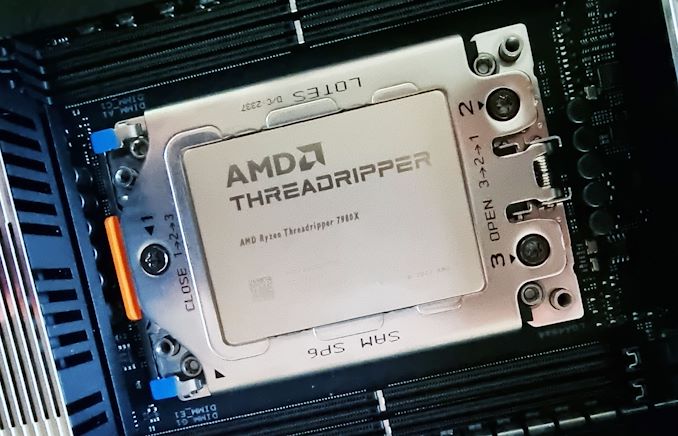
AMD's Ryzen Threadripper 7000 processors mark the latest additions to the high-end desktop (HEDT) market, a segment AMD wants to bring back to the mainstream. Based on AMD's proven Zen 4 architecture and built on TSMC's 5nm process, both of AMD's new Ryzen Threadripper 7000 lineups – Pro and non-Pro – are designed to bring more cores and more I/O to the high-end desktop and workstation markets. Altogether, AMD is offering three new Ryzen Threadripper 7000 SKUs, the top-end 7980X with 64 cores, the mid-tier 7970X with 32 cores, and the entry-level chip in the line-up, the 24-core 7960X.
As has been the case for the vanilla Threadripper series since its inception, the purpose of AMD's server-derived processors is to meet the demands of desktop users who require extreme multitasking capabilities and high throughput for complex workloads, offering more CPU cores, more memory channels, and more PCIe lanes than what otherwise comes with AMD's desktop platform. At the same time, the basic Threadripper lineup differentiates itself from the professional workstation-focused Threadripper Pro chips – in this case, AMD's new Threadripper 7000 WX-series – by leaving out some of the more 'Pro' features that come with that hardware, as well as some of the CPU/memory/IO hardware that the even more powerful Pro chips offer. Segmenting both product lines is a good idea, given the pedigree and use cases of both the Pro WX-series and non-Pro chips are aligned with. With Threadripper 7000, AMD targets customer bases that need CPUs more powerful than a desktop Ryzen processor but not as exotic (or expensive) as what's essentially a full server-grade chip.
After taking a break in the previous generation, AMD is once again offering a HEDT-focused line-up to consumers, which is as grandiose as it is interesting. When AMD launched the Zen 3-based Threadripper 5000 series, AMD only ever released the workstation-focused Pro parts, leaving users looking for semi-affordable high-core count CPUs in the dust. This time, AMD has decided to bring the HEDT back, creating a pair of Threadripper lines similar to the Threadripper 3000 family in 2019.
Today in our AMD Ryzen Threadripper 7000 series review, we're going to be focusing on the top two chips from the trifecta, the top-end Ryzen Threadripper 7980X (64C/128T) and the middle of the road 7970X (32C/64T). We'll be comparing them to the previous Ryzen Threadripper 3000 series and directly against Intel's Sapphire Rapids Workstation CPUs, including the flagship Intel Xeon w9-3495X. Also, we'll be putting them against the desktop flagships, such as the Intel Core i9-14900K and the AMD Ryzen 9 7950X, to see how much more performance AMD's new foray into HEDT users can squeeze out. Is there a suitable place in the market for HEDT chips, given how far desktop processors have progressed within the last couple of years? Let's find out.
AMD Ryzen Threadripper 7000 Series: Bringing HEDT Back
After AMD skipped releasing a vanilla Threadripper processor as part of their Zen 3 architecture family – what would have been the Ryzen Threadripper 5000 series – things certainly looked dim for the future of the high-end desktop (HEDT) market. Combined with Intel also skipping HEDT that generation by not bringing down their troubled Ice Lake server silicon to HEDT products, and it was looking like HEDT may have finally been pushed out by more powerful desktop processors. But a generation later, and things have seemingly changed for the better for the HEDT market. Looking to further capitalize on the success of their Zen 4 architecture, AMD is bringing back HEDT models to the market via the Threadripper 7000 series, with three new chips ranging up to 64C/128T, all with full Zen 4 cores.
The AMD Ryzen Threadripper 7980X, 7970X, and 7960X are the latest entries in the HEDT market, bringing significant advancements in processing power and efficiency. The 7980X is the top SKU with 64 cores/128 threads, a turbo clock speed of up to 5.1 GHz, and a base clock of 2.5 GHz. The 7970X has half the cores and threads, for 32 cores/64 threads altogether, and offers a higher base frequency of 3.2 GHz and matches its higher-end counterpart's 5.1 GHz turbo clock.
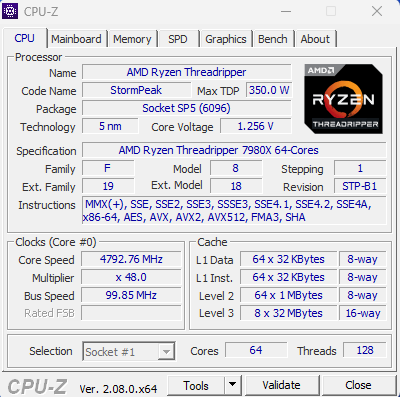
AMD Ryzen Threadripper 7980X (64C/128T) CPU-Z Screenshot
These chips are aimed at driving demanding multi-threaded applications that can saturate high core count CPUs, such as advanced content creation, 3D rendering, and complex computational tasks. The 7980X, the more powerful of the two, is particularly suited for scenarios requiring extreme multitasking and high throughput.
Conversely, though AMD isn't sampling it for today's review embargo, the Threadripper 7960X represents the other side of the coin. With 24 cores/48 threads, a base frequency of 3.2 GHz and a turbo clock speed of up to 5.3 GHz, the 7960X offers the fewest cores, but still all of the memory bandwidth and I/O lanes the Threadripper platform can provide, making it especially well suited for tasks where data throughput rather than raw CPU performance is the bottleneck. Still, with fewer CPU cores, it's the entry-level part (if you can call it that) to AMD's new HEDT platform, with an MSRP of $1499.
| AMD Ryzen Threadripper 7000 (Zen 4) | ||||||||
| AnandTech | Cores | Base Freq |
Turbo Freq |
PCIe (Gen 5) |
Cache (L3) |
TDP | DRAM (RDIMM) |
Price ($) |
| 7980X | 64 / 128 | 2500 | 5100 | 48 | 256 MB | 350W | 4 x DDR5-5200 | $4999 |
| 7970X | 32 / 64 | 3200 | 5100 | 48 | 128 MB | 350W | 4 x DDR5-5200 | $2499 |
| 7960X | 24 / 48 | 3200 | 5300 | 48 | 128 MB | 350W | 4 x DDR5-5200 | $1499 |
Regarding memory and I/O capabilities, the Threadripper 7000 series supports quad-channel DDR5 memory and up to 48 PCIe 5.0 lanes, offering plenty of bandwidth for devices such as storage and graphics. Unique to the Threadripper 7000 platform (versus AMD's consumer platform), AMD supports RDIMMs here, allowing the for support for up to 1 TB of memory via DDR-5200 RDIMMs – over 5x as much memory as desktop Ryzen.
These processors represent AMD's commitment to pushing the capability of desktop computing power, catering to both professionals, enthusiasts, and everything in between. They are designed for users who require more than what standard desktop CPUs can offer. The Ryzen Threadripper 7980X and 7970X are designed to excel in multi-threaded workloads. Their theoretical ability to handle more diverse and intensive workloads than desktop processors makes them a pivotal choice in the current HEDT landscape.
One step above this is the Threadripper 7000 Pro WX series, which has support for 8 channels of memory, pushing the performance where workloads, instruction sets, and applications can benefit from both more memory bandwidth and higher memory densities.
The TRX50 Chipset: Designed For Threadripper 7000, Supports TR Pro 7000 WX-Series
Launching alongside the new Threadripper chips is AMD's TRX50 chipset. The TRX50 platofrm uses the new 4844 pins sTR5 socket, which like the Threadripper processors themselves, is derived from AMD's EPYC offerings – in this case the SP6 socket AMD introduced for their lower-priced EPYC 8004 (Siena) processors. Despite the identical pin count, it should be noted that sTR5 and SP6 are not pin compatible.
Meanwhile, looking at things on a generational basis, there is a degree of cooler compatibility. Specifically, older socket sTRX4 Threadripper coolers will still fit on the 58.5mm x 75.4mm sTR5 socket. This means users upgrading from sTRX4 chips should theoretically be able to recycle their old cooler. However, they would certainly need to be capable of supporting a higher TDP of 350 W.
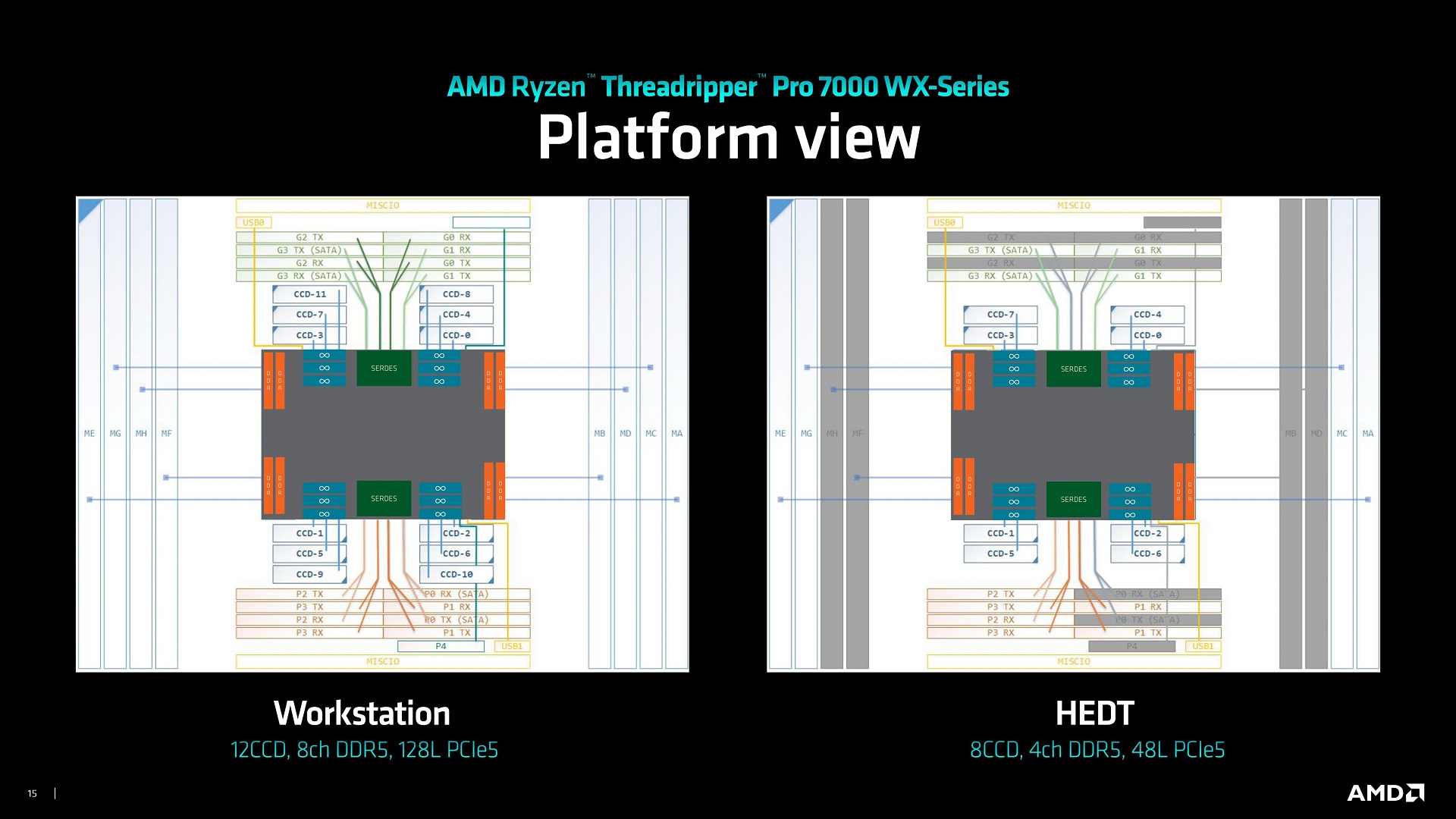
Platform diagram of the WRX90 (left) and TRX50 (right)
For memory and I/O, the TRX50 platform supports 4-channel DDR5 memory and 80 PCIe lanes. Though the latter ends up being an unexpected mix of PCIe 5.0 lanes and PCIe 4.0 lanes, with 48x PCIe 5.0 lanes alongside a further 32x PCIe 4.0 lanes. As PCIe Gen5 is more complex to implement and longer runs require re-drivers, AMD has opted to limit the manufacturing costs of motherboards by not running quite so many max-speed PCIe lanes. At the same time, the idea of TRX50, especially when directly compared to WRX90 for Threadripper Pro 7000 WX-series chips, is that it is a cut-down version to provide everything users need on a middle-abridged chipset between desktop AM5 and WRX90 – meaning that dialing back some PCIe lanes to 4.0 also provides some feature differentiation between the two Threadripper lineups.
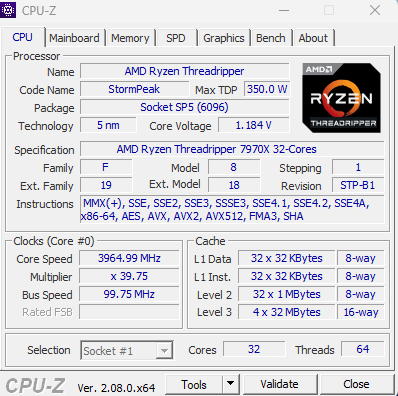
AMD Ryzen Threadripper 7970X (32C/64T) CPU-Z Screenshot
It is worth highlighting that Threadripper 7000 Pro chips can also be used in TRX50 motherboards. But, of course, they will be subjected to the same memory channel and I/O limitations. In that respect, TRX50 boards can be used as a budget board pairing for Threadripper Pro chips. Otherwise, the converse is false: non-pro Threadripper 7000 chips cannot be used in WRX90 boards, as illogical as that would be.
Test Bed and Setup
We use the following test systems for our AMD Ryzen Threadripper 7980X, 7970X, and Intel Xeon WS-series testing:
| AMD Ryzen Threadripper 7000 Series | Intel Sapphire Rapids Xeon Series | |
| CPU | Ryzen Threadripper 7980X ($4999) 64 Cores, 128 Threads 350 W TDP Ryzen Threadripper 7970X ($2499) 32 Cores, 64 Threads 350 W TDP |
Xeon W9-3495X ($5889) 56 Cores, 112 Threads 350 W TDP |
| Motherboard | ASUS Pro WS TRX50-SAGE WIFI | ASUS Pro WS W790E-SAGE SE |
| Memory | G.Skill Zeta R5 Neo 4x32 GB DDR5-5200 RDIMM |
SK Hynix 8x16 GB DDR5-4800 RDIMM |
| 6 | NZXT Kraken 360 360mm AIO | Noctua NH-U14S DX-4677 |
| Storage | SK Hynix Platinum P41 2TB PCIe 4.0 x4 | |
| Power Supply | MSI A1000G 1000W | |
| GPUs | AMD Radeon RX 6950 XT, 31.0.12019 | |
| Operating Systems | Windows 11 22H2 | |
For our head-to-head comparison, we have on hand Intel's latest Sapphire Rapids Xeons. Like the Threadripper series, the Xeons are split up into two sub-groups – the full-fat Xeon w-3000 series for high-end workstations, and the lighter Xeon w-2000 series for more mainstream workstations. Unfortunately, the only Xeons we have on hand are the w-3000 series parts (which is what Intel sampled for reviewing when those were released), so it's not quite an apples-to-apples comparison, especially as the w-3000 Xeons support 8 channels of memory (versus TR's 4 channels).
Still, there are similarities in core and thread count and TDP that should offer some enlightening data. Both platforms have a max TDP of 350W, and the Intel W9-3495X we're using is a 56C/112T chip, while the Threadripper 7980X is a 64C/128T chip.
For added flavor, we'll be adding in data from both AMD and Intel's flagship desktop processors, including the Core i9-14900K, the Ryzen 9 7950X, and Ryzen 9 7950X3D. We will also be comparing the new AMD Threadripper 7000 series chips to their previous counterparts, including the AMD Ryzen Threadripper 3990X (64C/128T), which we reviewed in 2020, as well as the Threadripper 3970X (32C/64T).
Read on for our extended analysis.


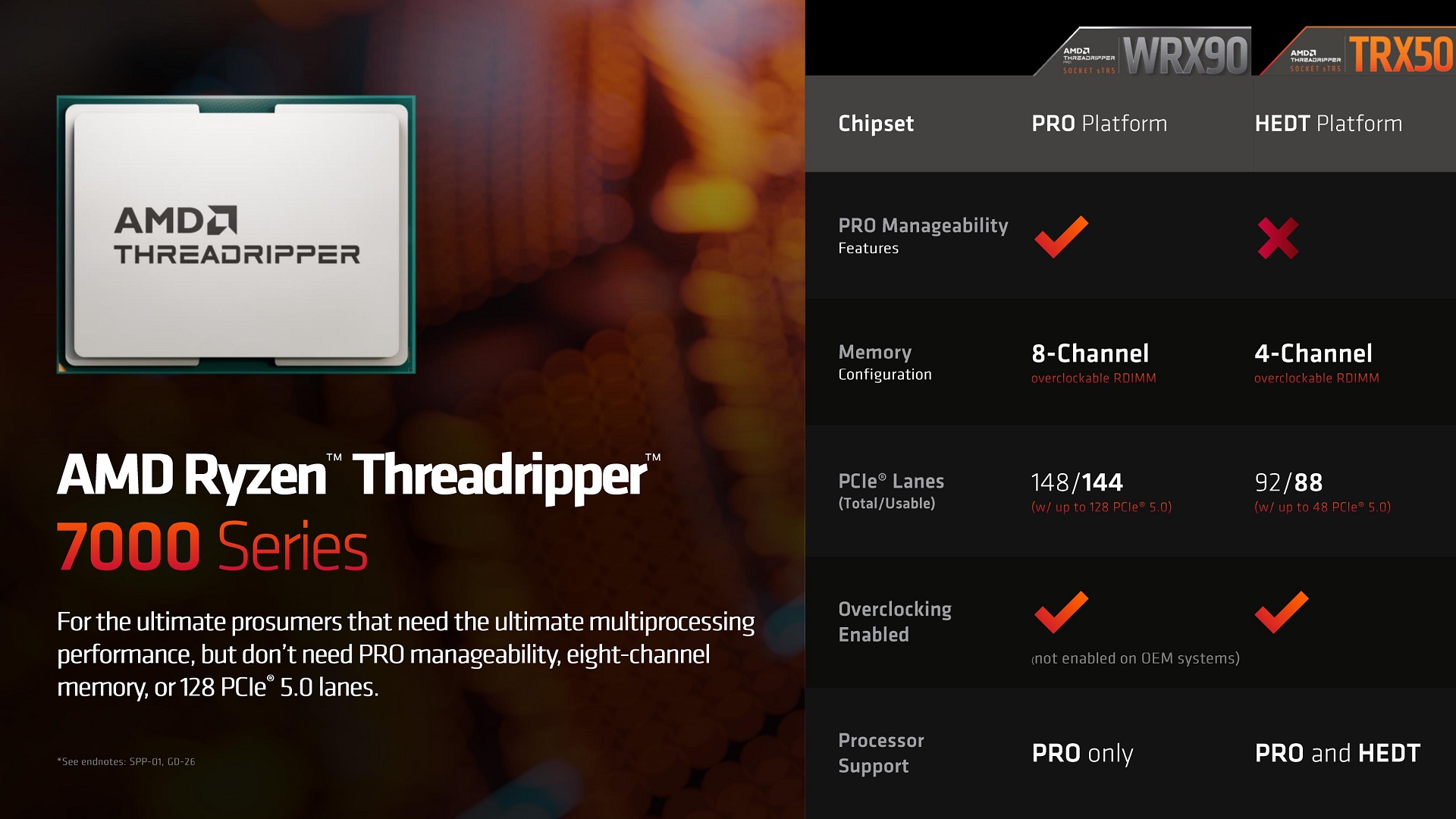








66 Comments
View All Comments
Jansen - Monday, November 20, 2023 - link
Bit disappointing that the memory controller only supports DDR5-5200, considering that JEDEC compliant DDR5-6400 RDIMMs are available.Ryan Smith - Monday, November 20, 2023 - link
At the end of the day it's the same I/O die as Genoa. So it comes with roughly the same restrictions.TEAMSWITCHER - Monday, November 20, 2023 - link
Not surprised by this at all. My 3960X Threadripper system was never able to run 64gb (16gb x 4) at even the promised DDR4-3200 speed. I tried three different RAM kits and even a different CPU (replaced by AMD) and the problem never went away. In the end I believe it to be motherboard issue, it was simply incapable of running stable with any RAM faster than DDR-3000.After spending so much on the ASUS Zenith II Extreme Alpha motherboard, 64GB of DDR-3600 RAM, and a $1400 CPU, the end result was very disappointing. Support from ASUS, AMD, and G-Skill was a long process, and eventually I had to just accept what was working and move on.
Ultimately, I don't believe that AMD and ASUS can properly deliver and support any HEDT platform that is worth the money they ask for it. I sincerely wish Intel would return to this segment, as I never had a problem with my X99 Deluxe II motherboard.
lemans24 - Monday, November 20, 2023 - link
Intel is definitely in HEDT with their xeon w-2400 chipsStormyParis - Monday, November 20, 2023 - link
I've blacklisted Asus. Lots of issues with both specs, reliability, and service.vfridman - Monday, November 20, 2023 - link
I have two systems with 3990X and two systems with 3970X, ASUS Zenith II Extreme Alpha motherboard and 256GB of 3600 speed G.Skill RAM in each system. All runs perfectly and completely stable, even with maxed out PBO overclock. I regularly run compilation jobs that require almost entire 256GB of RAM and never experienced any problems. I suspect you got unlucky with your CPU memory controller.Mikewind Dale - Tuesday, November 21, 2023 - link
I have a ThreadRipper Pro 3950X on a Supermicro WRX80 motherboard. I run 8x64 (512) GB of Supermicro-branded DDR4 3200 ECC RDIMM without a problem.Adam7288 - Wednesday, November 22, 2023 - link
Same exact config! Ram Bros.tygrus - Saturday, January 6, 2024 - link
How are you going with those >200GB matrices & statistics?Many years ago I had to use raw frequency stats, then a program to generate blocks of SAS code that could analyse cross-tab by cluster (weighted) with smaller subsets of interest from every possible combination (multi-morbidity data). Making sure the stats methods still gave correct results. Divide & conquer to fit in limited RAM of circa 2013 computers. In those days it was mostly constrained by single thread & disk/network IO speed (~100MB/s).
TEAMSWITCHER - Friday, November 24, 2023 - link
Ya know.. I have yet to build an AMD system that didn't suffer from some kind of issue. I don't think I'm unlucky either. I need to stop buying AMD gear thinking... "this time will be different." Because it never is.